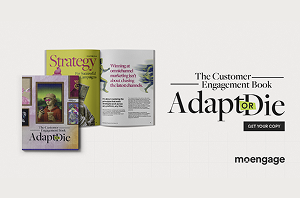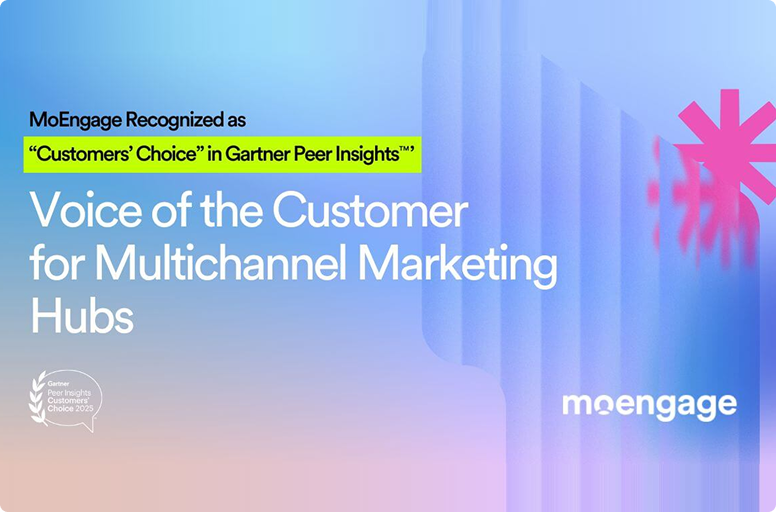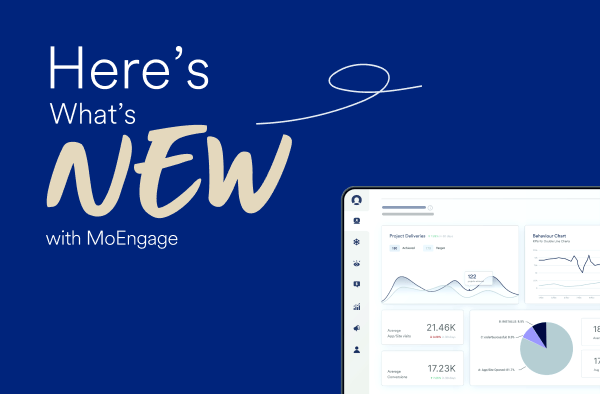How to Use Personalized Communication to Improve Customer Engagement
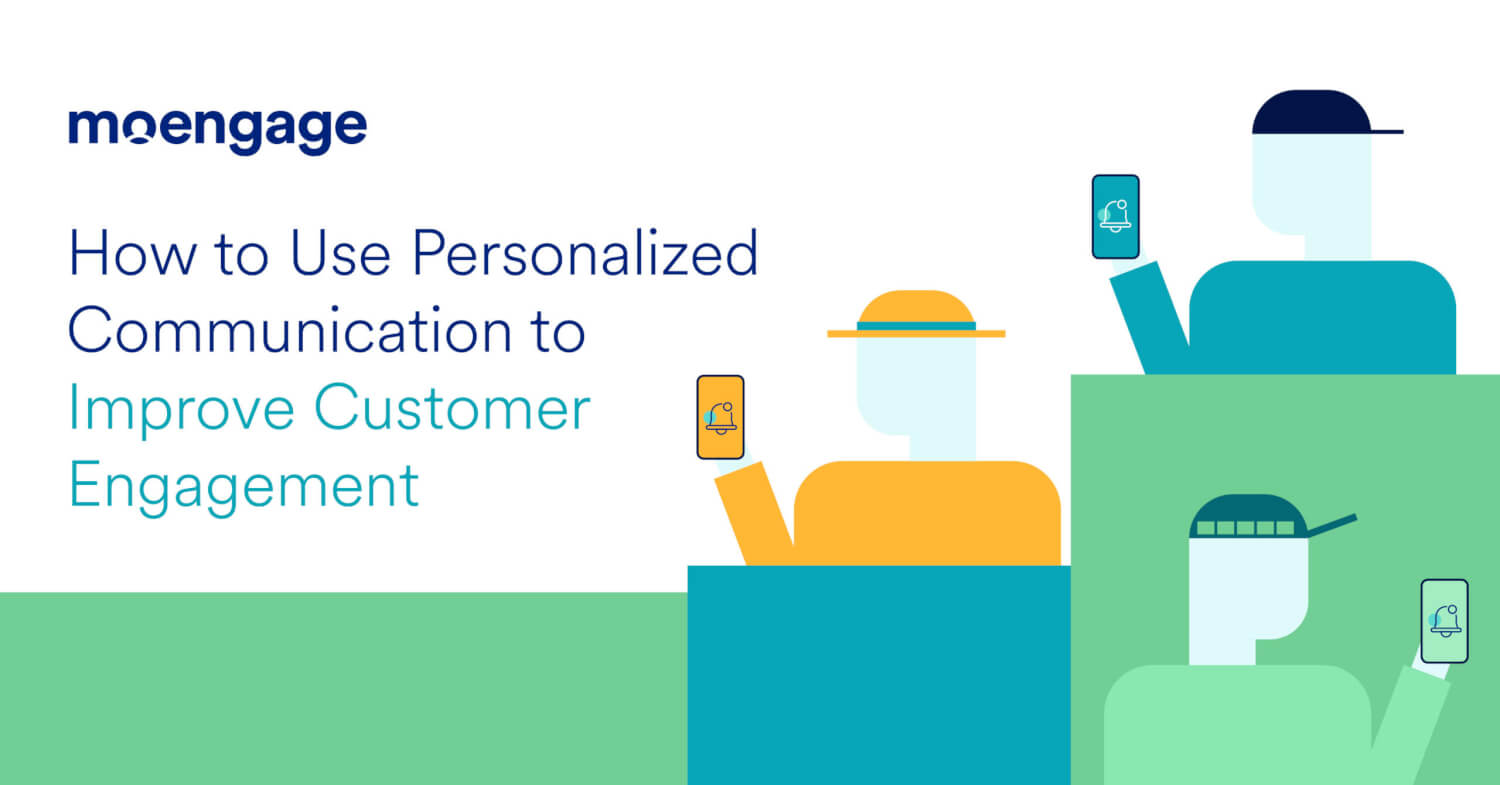
Reading Time: 9 minutes
Getting through to customers, at the heart of their concerns, is difficult when they are constantly bombarded with emails, SMS messages, and mobile push notifications. It requires carefully crafted, unique, and personalized communication that speaks directly to them.
It’s important to differentiate from competitive brands by engaging your customers with personalized marketing that shows that you understand them. This will help you build deeper and long-lasting connections with them.
In this article, we discuss the benefits of using personalized communication as well as specific examples from which you can take away learnings and apply to your own marketing communications.
What is Personalized Communication?
Personalized communication refers to messaging that is tailored to customers based on their personal needs, interests, and preferences. It helps to increase customer satisfaction and engagement, eventually fostering retention and brand loyalty.
Brands use methods such as customer segmentation, cohort analysis, behavioral insights, and other information to deeply understand their customers and deliver highly relevant campaigns that resonate with their audience.
What is the Current State of Personalized Communication?
Studies such as the Personalization Pulse Check report showcase that today’s consumers expect brands to deliver personalized omnichannel experiences based on their personal preferences. Most (56.1%) customers expect personalized experiences from brands they consistently shop from, and 29% of customers think the most frustrating part of an experience is when a brand doesn’t consider their preferences and provides general offerings.
Also, customers are willing to share their personal information to get these personalized experiences, with 67.3% of customers agreeing they are comfortable with brands using their data to curate a better experience and 65.9% of customers desiring a personalized shopping experience based on their past purchase history and personal interests.
Despite this, 42.7% of brands use very basic personalization strategies that only tailor messaging by name, age, and gender.
Even though most B2C marketers have a basic understanding of using customer insights to build personalized omnichannel campaigns, there is certainly room for improvement. Many brands struggle to paint a clear picture of their customers and campaigns because they have communication silos.
For brands to really excel at personalized communication, they need to develop an insights-led culture in their organization and include the right tools in their Martech stack. This will help them better analyze customer information to inform their decisions. And this goes deeper than just looking at who someone is based on arbitrary labels, and actually looks at understanding customers based on how they behave and what they are interested in.
When done right, personalized communication empowers brands to deliver messaging that customers love and engage with regularly.
Why Customers Respond Positively to Personalized Communication
Picture this; you browse products at two different online retail stores. One follows up with an email that promotes the featured items on their current sale, none of which you’d shown an interest in while browsing. The other store follows up with an email that shows you alternative options related to the items you browsed. Who do you choose?
The choice is pretty obvious, you’ll go with the retailer that can provide contextually relevant recommendations that are based on what you actually want. This example demonstrates why personalization is so effective.
So, why do you and other customers respond positively to personalized communication?
Personalized communication humanizes the brand experience for your customers. In turn, your customers feel heard, noticed, and appreciated, which greatly increases their overall satisfaction and encourages them to become brand loyalists.
That’s because personalized communication speaks to each individual customer directly and factors in their preferences. This means customers not only get messaging that’s addressed specifically to them, but also product and service recommendations that are relevant to their needs.
By sending customers such relevant communication, you can build a strong relationship with them and encourage them to actively engage with your brand.
4 Benefits of Using Personalized Communication to Engage Customers
Personalizing customer communication directly benefits your business in a number of ways:
- Drives conversions and increases revenue: Personalized communication delivers customers messaging and product recommendations that are tailored to them, which lead to more conversions and generates more revenue.
- Improves customer satisfaction: Customers that get contextually relevant messaging that improves their shopping experience are far more likely to be satisfied with your brand.
- Increases customer engagement: Customers who receive timely, relevant messaging are far more likely to engage with your app/website regularly.
- Builds true brand loyalty: Consistently relevant, personalized communication that speaks to your customer’s preferences develops a meaningful relationship, based on trust, that eventually leads to deep brand loyalty.
- Provides a competitive advantage: Set yourself apart from the competition by offering personalized communication that shows your customers you understand — and genuinely care about — them.
The thing about personalizing customer communication is that it can be applied with every customer interaction across every communication channel and touchpoint.
But how exactly does personalization work and what are the best practices? The next section covers just that.
How to Personalize Communication With Customers
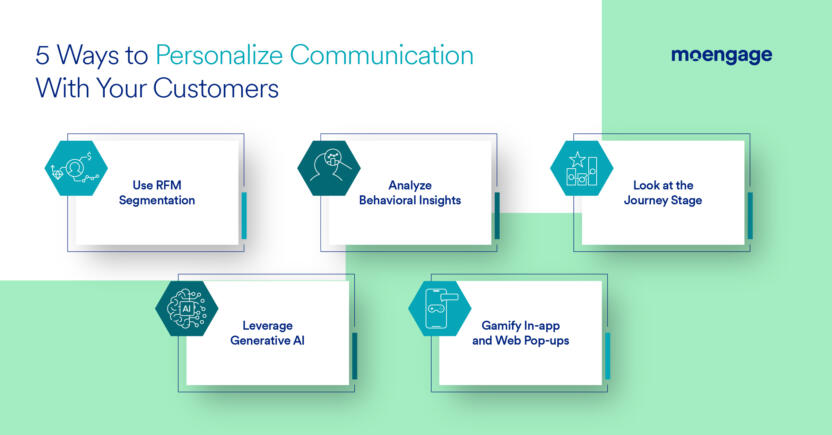
Per our 2024 Cross-Channel Marketing report, 39.5% of B2C companies said delivering personalized communication was one of their top challenges.
Delivering personalized communication that actually resonates with your customers is no easy feat. You have to be able to understand them, develop personalized messaging, and then optimize the delivery timing and channel to ensure maximum exposure and traction.
Below, we look at how to deliver personalized communication to customers in a meaningful way.
Use RFM segmentation
Customer segmentation is the backbone of personalization. Without knowing your target audience, you’ll never be able to effectively personalize content for them.
RFM analysis allows brands to segment customers based on the recency, frequency, and monetary attributes of their interactions.
Customers who show similar R, F, and M scores and RFM aggregate scores, are grouped into the same RFM segments. This includes segments such as ‘price sensitive’, ‘needs attention’, and ‘can’t lose them’.
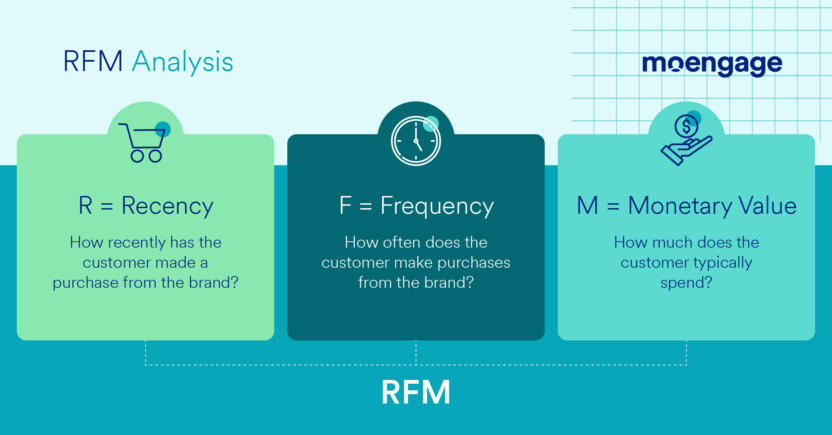
For example, a customer that is price sensitive may be the prime candidate for a personalized discount during a special occasion, that could give them the nudge they need to complete a purchase.
When leveraged properly, such insights-led engagement practices empower brands to truly connect with their customers based on what they are most interested in.
Analyze behavioral insights
Behavioral segmentation can not only inform your overall strategy, but it can enable you to adapt to your customer’s needs and preferences quickly and effectively.
You can group customers on the basis of:
- Their overall purchasing behavior (for example impulsive buyers and offer seekers)
- Their behavior around special occasions and holidays
- The benefits they seek (for example convenience, affordability, and status)
- Their loyalty status
Since this is based on dynamic data, you can maximize customer engagement by building event-triggered campaigns that are automatically initiated when customers take a particular action.
This ensures that the personalized communication you send is always relevant to what the customer is currently doing, how they use your product, and what they are generally interested in. Even better still, it ensures customers get this communication at the optimal time.
Look at the customer’s journey stage
B2C personalization isn’t just about knowing who your customers are, it’s also about understanding where and when they engage with your brand. That’s because customers engage with your brand very differently depending on the stage they’re at in the customer journey.
A new customer isn’t at the same stage as a loyal customer of three years, and they shouldn’t be treated the same. Instead, provide customers with contextually relevant messaging based on where they are in the customer journey and their tenure with your brand.
Newly acquired customers will need onboarding and welcome sequences that familiarize them with your service and activate them. Loyal customers of three years need personalized offers and rewards that keeps them engaged with your brand — and leads to re-conversions.
You can use acquisition cohort analysis to identify trends and patterns in the customer lifecycle, to optimize the customer experience and increase customer lifetime value.
Leverage AI to personalize copy
Delivering consumers personalized communication is no easy task, especially as your audience grows and becomes increasingly diverse. How do you continue to deliver unique, engaging content for different customer segments as you scale?
Generative AI makes it possible for brands to automatically create — and optimize — personalized copy for their communication across email, web, mobile push, SMS, etc., based on different use cases. This can save teams an immense amount of time and help them continue to deliver personalized marketing as they grow and scale.
Gamify in-app and web pop-ups
Gamification is a great strategy for gaining traction and incentivizing consistent engagement, as it encourages active participation. It doesn’t just give customers the chance to get a limited-time reward, but it gives them a chance to ‘win’ one.
Personalizing these experiences so customers get relevant communication ensures that this victory is personal and rewarding for each customer. Adding gamification elements such as “Scratch Cards”, “Spin the Wheel”, and “Countdown Timers” can help you acquire customers with offers that speak to them, or foster regular engagement with customers who want to return each day to get their daily reward.
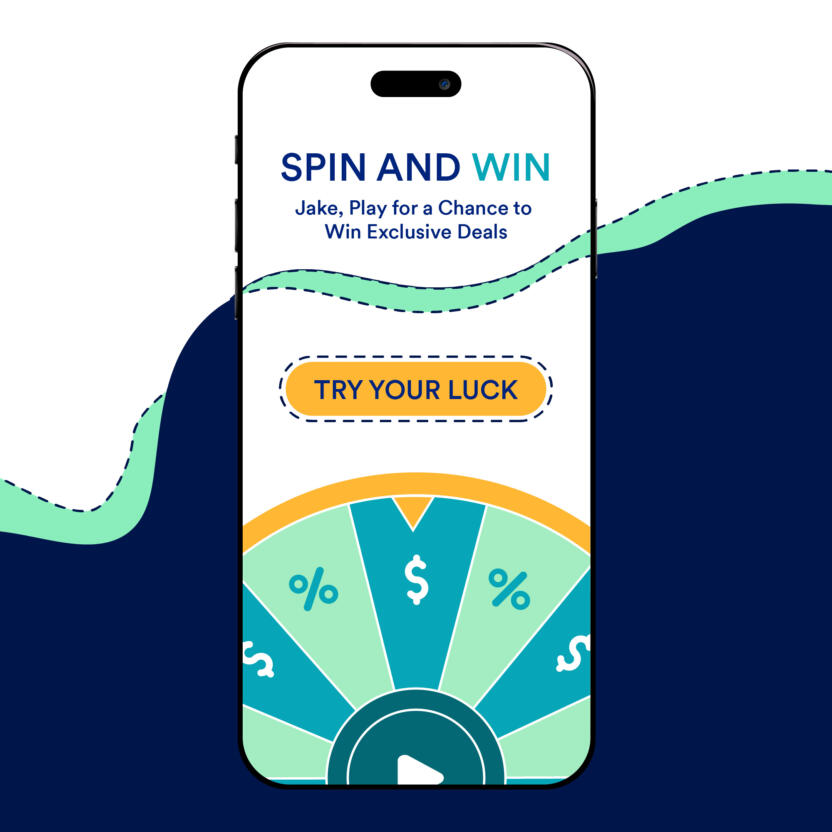
6 Personalized Communication Examples to Learn From
Now that we know various tactics for implementing personalization in engagement campaigns, let’s explore personalization in action by looking at specific real-life examples.
1. McDonald’s crafts personalized email subject lines that hook readers and increase open rates
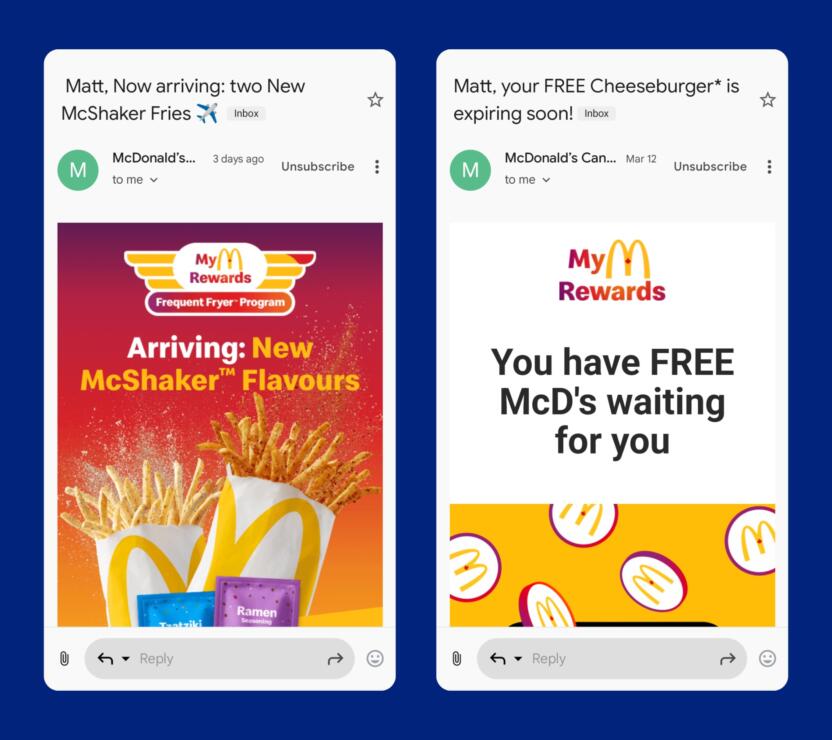
Even the best email marketing campaign in the world will do no good if your customers never see it.
McDonald’s captivates readers — and increases open rates and engagement — with informative, enticing email subject lines. These are tailored to address the customer directly by name, making them feel more personal.
Using such email subject lines, McDonald’s alerts customers of new menu items available in their geographic location and activates inactive customers by reminding them of unused offers when they are close to expiring. This helps to grab the customer’s attention and increase open rates.
2. Amazon uses web push notifications to recommend personalized products to customers

Amazon uses omnichannel analytics to deeply understand every single customer interaction. This data informs everything Amazon serves to their customers, including product recommendations, promotional offers, and other communication.
Amazon not only leverages browsing history, purchase activity, and behavioral data to personalize their recommendations, they also look at what items customers in a similar segment purchased.
This empowers Amazon to funnel customers towards a conversion. It’s also one of the most effective ways to increase average order value (AOV) through targeted cross-selling or upselling.
3. Wealthsimple sends personalized service alerts through push notifications
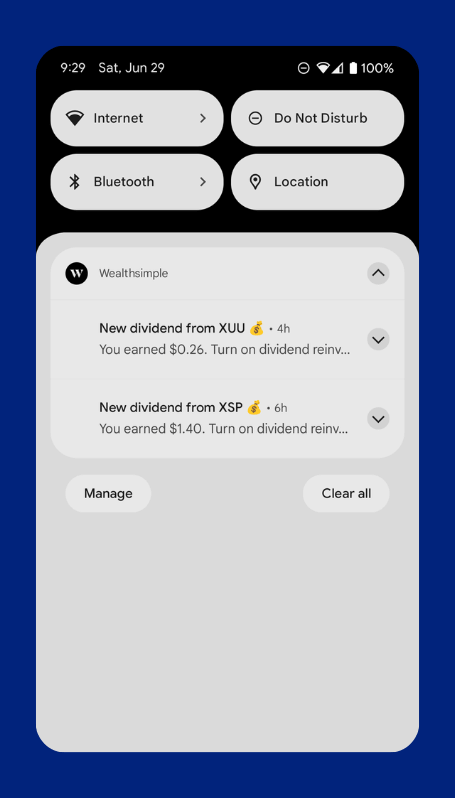
To keep customers updated on their investments in real-time, Wealthsimple sends push notifications that alert them of critical activities, such as completed buys/sells, all-time highs or lows, and dividend payments.
These updates are unique to each customer and sent in a timely manner. They keep customers aware of their financial portfolio’s performance in a timely manner. This helps to build trust with customers as they know their finances are well taken care of.
4. McDonald’s uses event-triggered campaigns to automatically send contextually relevant marketing in real time
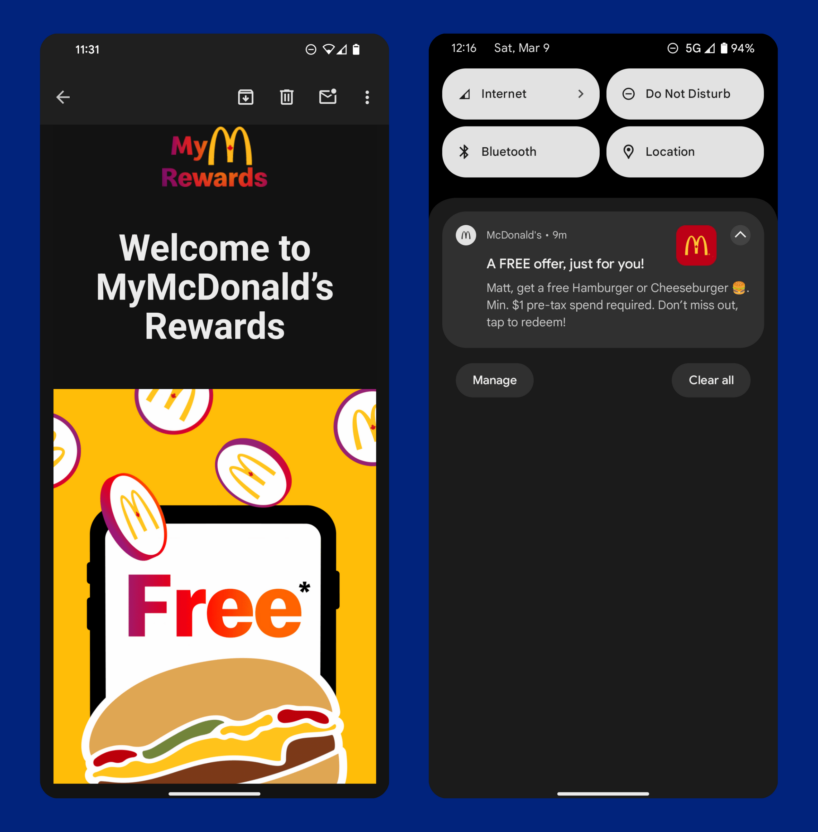
It’s imperative that brands send the right message at the right time.
That’s why McDonald’s uses event-triggered marketing campaigns to ensure customers get the right campaign based on their activity and where they are in the customer lifecycle.
Newly onboarded customers who complete a MyMcDonald’s Rewards sign-up are automatically served a welcome sequence that helps onboard them to the rewards program. This includes an email welcome sequence and a promotional offer delivered over mobile push to maximize engagement and get the new customer to become active.
5. Spotify uses mobile push notifications to promote artists and increase listenership
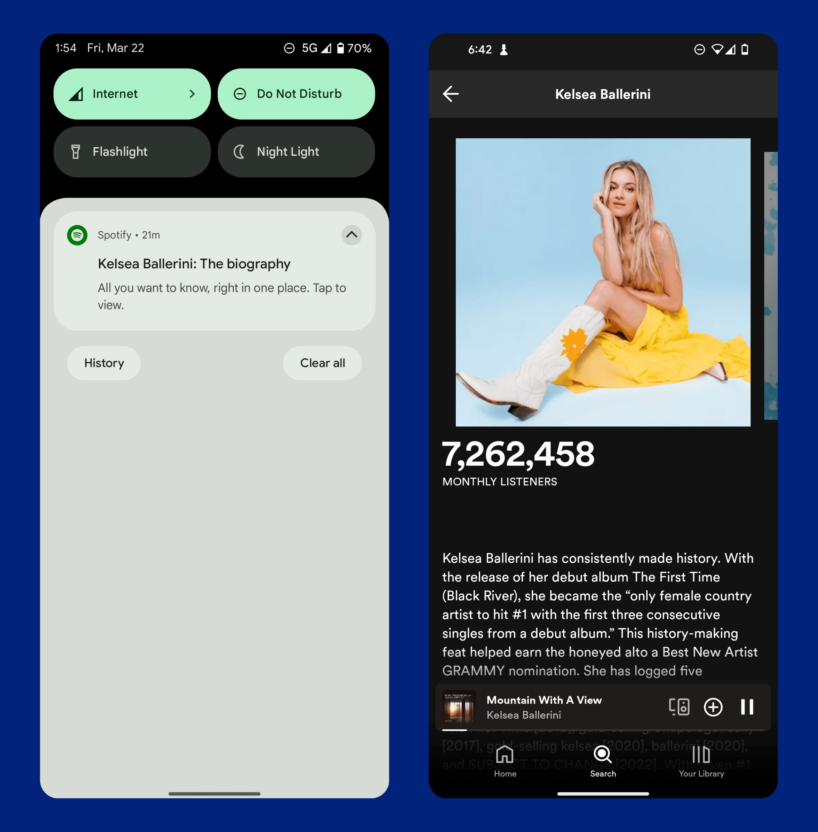
Media & Entertainment brands like Spotify rely heavily on consistent, active engagement with their content.
Spotify sends personalized push notifications that recommend artists listeners have recently heard, promoting further engagement with that artist (and Spotify’s app). While this doesn’t necessarily ‘sell’ the customer anything, it provides customers with an ideal experience by connecting them with more of the content they love. This increases their time spent on the app and nurtures them towards a subscription renewal.
By offering relevant recommendations based on the customer’s behavior, Spotify shows its customers it understands them. The more accurate these recommendations are, the more satisfied customers are and the more likely they are to become brand loyalists.
6. theScore connects customers with live events with relevant, perfectly timed mobile push notifications
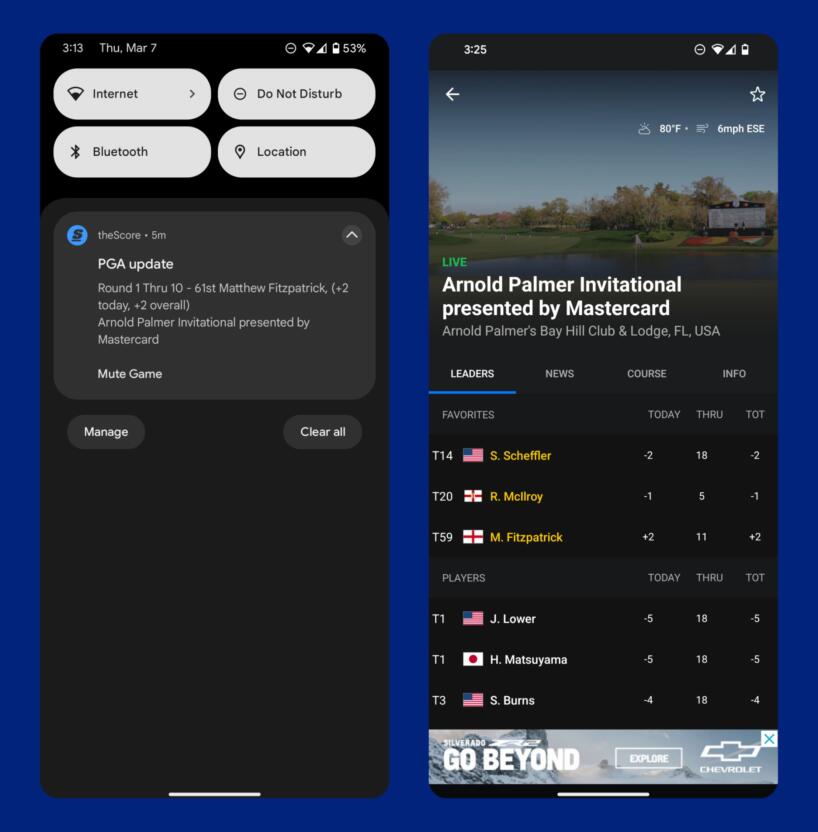
Popular sports news and score tracking service, theScore, increases engagement with personalized mobile push notifications that alert customers of news, scoring changes, and more, related to their favorite sporting events.
Customers are able to choose — and follow — their favorite leagues, teams, and players, so they get up-to-date information on when these teams play and live scoring so they can track teams even when they’re on the go.
Using this information, theScore is able to serve customers extremely relevant push notifications that let them know when a player gets traded, when a game starts, and when an overtime goal is scored (to spell certain victory or defeat for their favorite team).
By sending customers content they love and care about, the Score dramatically increases engagement, app stickiness, and retention.
Deliver Highly Personalized Communication with MoEngage
Personalized communication is all about providing customers with relevant messaging that resonates with them better, increasing satisfaction, engagement, and conversions.
It helps you go a long way in humanizing your brand, allowing you to foster deep, meaningful relationships with customers. It enables you to show your customers that you not only understand them and their needs, but that you care about them individually.
MoEngage’s personalization capabilities can help you send relevant messages to your customers, in a timely manner, that are guaranteed to create an impact.
Schedule a demo today to find out how you can create hyper-personalized communication with MoEngage, that your customers will love — and constantly interact with.

